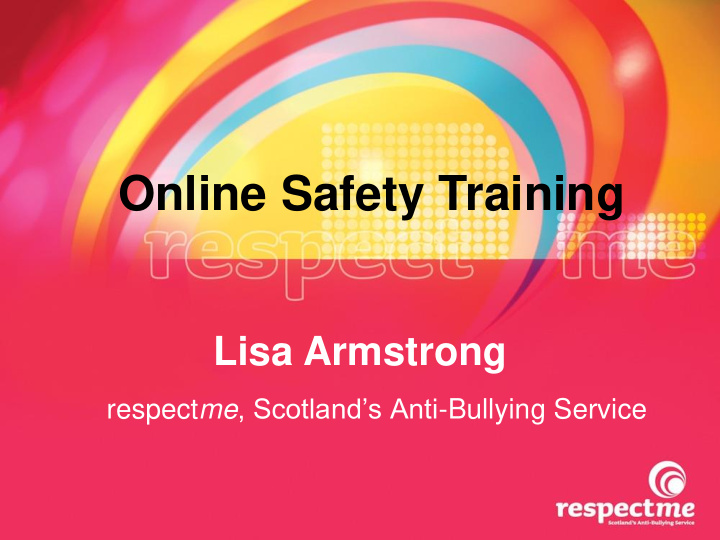



Online Safety Training Lisa Armstrong respect me , Scotland’s Anti -Bullying Service
Training Aims • Consider what we mean by bullying, including on – line bullying • How young people use technology-the risks & challenges • To think about our role in keeping our children safe online • Practical skills to ensure safe, secure settings • Learn from each other !!!!
What Do We Mean By Bullying? • Bullying is behaviour that has an impact on a person • Bullying can make people feel hurt, frightened and left out • Even if the behaviour stops, the impact can last a long time
Bullying Behaviour Can Include: • Being called names, teased, put down or threatened • Physical confrontations-hitting, kicking • Having belongings taken or damaged • Being ignored, left out or having rumours spread about you • Receiving abusive messages or posts • Being targeted because of who people think you are 4
What is Online bullying? • The same type of behaviour but it takes place online:- On social media, online gaming, texts, instant messaging • Online bullying, like all bullying behaviour is never acceptable. It is not a normal part of growing up. • Switching off the internet is not the answer
Communication…It’s good to talk! Discuss the methods of communication you used in your: • Teens • Twenties • Now • How did your communication methods change through time and why? • Do you feel these changes were positive or negative?
The Internet is a Place, Not a Thing
Still Going Somewhere
What Risks Face Our Children and Young People? • Bullying • Exploitation – predatory behaviour • Violence • Abuse • Blackmailed/coerced • Left out • Scammed – ripped off • Gossip or lies Do these take place on – line, or face to face?
How Do We Support Our Children To Be Safe Online? • How to eat at the table • Learning to swim • Riding a bike • Crossing the road • Playing games • Stranger Danger ……..and learning to be safe online?
What Parents/Carers Need To Do • Communicate/build a trusting relationship • Let them know you are there to help if something upsetting happens online • Have an agreement about what’s allowed on the internet- Be a good role model! • Take time to teach & discuss about keeping safe online e.g. passcodes, location settings, blocking & reporting, their online behaviour, being share aware • Check/set privacy settings & parental controls • Be aware of age restrictions for sites, apps, games
And finally… • Keep the discussion about internet safety open and on-going • Remember settings are public by default and need to be changed • Only then can you control who is able to see pictures and posts. If I can see it I can copy it!
Practical Session
Where Are They Going? • Always changing
Facebook Click here to open drop down menu Click on Privacy button
Friends is safest setting
Friends is safest
Type name of contact you would like to block here
Instagram 2. Click on the settings icon 1. Click on the address card icon to open your profile
Instagram Scroll to “ photo privacy” option and click on it
3. Make sure that the “photos are private” box is ticked 4. Click “Yes I’m sure ” 1. Click on the address card icon to open your profile
Snapchat
Twitter Click on settings icon Choose settings
Scroll down to privacy and ensure there is a tick in box “Protect my Tweets” Remember to save changes
Internet Safety-Further Resources • CEOPC (Child Exploitation and Online Protection Centre) www.ceop.police.uk/ • Thinkuknow www.thinkuknow.co.uk/parents • UK Safer Internet Centre www.saferinternet.org.uk/ • Cybersmile www.cybersmile.org/ • Digizen – promoting safe online communities www.digizen.org/ NSPCC Net Aware http://www.net-aware.org.uk/ • Internet Matters http://www.internetmatters.org/
Thank you lisa.armstrong@respectme.org.uk
Recommend
More recommend